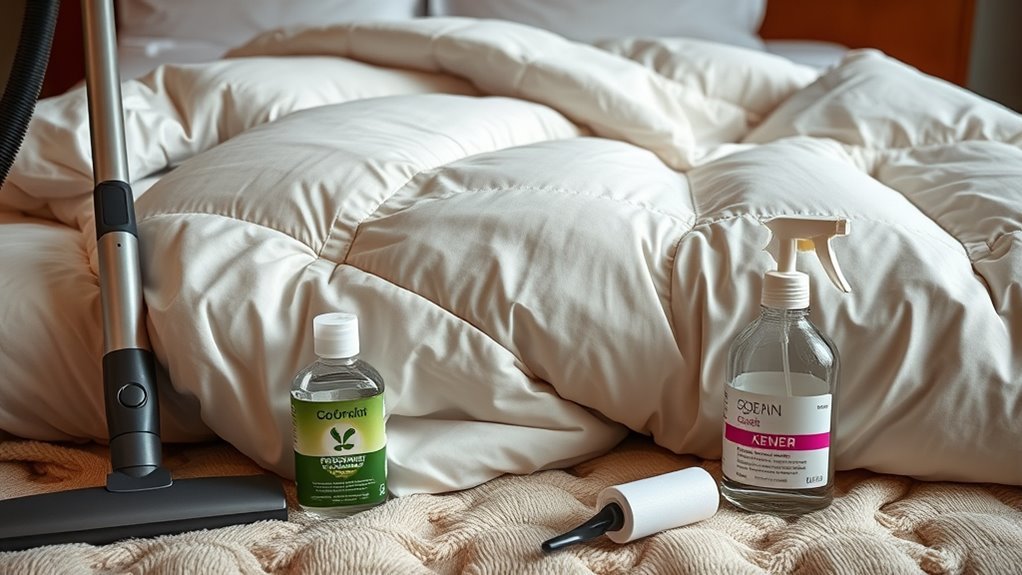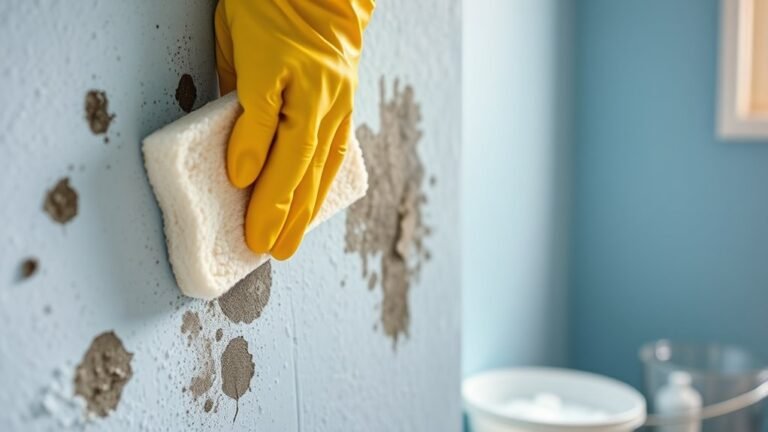How Often to Dry Clean Comforter
You should dry clean your comforter every six months, especially if it’s down or feather-filled, to maintain freshness and a healthy sleep environment. For synthetic comforters, an annual cleaning is usually sufficient. Before cleaning, check for stains and treat them as needed. Using duvet covers can also extend the time between cleanings. If you want tips on the best cleaning methods and maintenance practices, there’s more to explore.
##

Maintaining the freshness of your comforter is crucial for a cozy and healthy sleep environment, and this article will provide you with essential information on how often to dry clean your comforter based on its materials. Whether you own a delicate down or feather comforter that requires special care every six months, or a more durable synthetic option that can be cleaned once a year, we will guide you through the best practices for keeping your bedding in top-notch condition. Additionally, if you struggle with allergies or excessive sweating during the night, we’ll discuss the benefits of more frequent cleaning to combat dust mites and odors. By understanding the specific needs of your comforter, you’ll be well-equipped to establish a cleaning routine that ensures your bedding remains fresh and inviting.
Preparation For Cleaning
Before you start the cleaning process, it’s important to prepare your comforter properly to guarantee the best results. Begin with a pre-cleaning assessment: check for any stains or damage. If you spot stains, treat them according to the washing instructions on the care label. This guarantees you’re using the right method and product. Next, remove any bedding or accessories attached to your comforter, like duvet covers or decorative pillow shams. If your comforter’s oversized, verify your washing machine can handle it; otherwise, consider a laundromat or professional cleaning service. Finally, shake out the comforter to remove dust and allergens, setting the stage for a thorough cleaning. Proper preparation will make a significant difference in the outcome of your cleaning efforts.
Tools and Chemical Required

After confirming your comforter is ready for cleaning, gather the right tools and chemicals to achieve the best results. For effective dry cleaning and fabric care, you’ll need:
| Tools | Chemicals |
|---|---|
| Vacuum cleaner | Dry cleaning solvent |
| Stain remover | Fabric freshener |
| Soft brush | Spot cleaning solution |
Using the vacuum cleaner will help eliminate dust and debris, while the soft brush is perfect for gentle surface treatment. For any stubborn stains, a quality stain remover is essential. Finally, a dry cleaning solvent guarantees your comforter maintains its integrity and softness. With these tools and chemicals, you’re well-equipped to handle the cleaning process with ease and confidence. Choosing gentle, non-abrasive cleaners helps protect the fabric’s finish and longevity.
How to Clean:

Step 1: Check the Care Label
- Locate the care label on your comforter, usually found on one of the corners.
- Read the instructions carefully to determine the recommended cleaning method (machine wash, hand wash, or dry clean).
- Note any specific temperature settings or detergent recommendations indicated on the label.
Step 2: Prepare for Washing
- If machine-washable, ensure your washing machine has enough capacity to accommodate the comforter without overcrowding.
- Use a gentle cycle setting to prevent damage to the fabric.
- Select cold or warm water based on the care label instructions; cold is generally safer for most materials.
Step 3: Choose the Right Detergent
- Opt for a mild detergent that is free of bleach and harsh chemicals, as these can harm the fabric.
- Measure the appropriate amount of detergent according to the size of your comforter and the machine’s instructions.
Step 4: Add Extra Fluff for Down Comforters
- If your comforter is filled with down, consider adding a couple of clean tennis balls or dryer balls to the dryer.
- This helps to break up clumps of down and ensures it fluffs up properly during the drying process.
Step 5: Washing Process
- Place your comforter in the washing machine, ensuring it is evenly distributed to maintain balance.
- Start the wash cycle, allowing it to complete fully.
- For synthetic materials, a warm water wash may be beneficial for a thorough clean.
Step 6: Drying the Comforter
- After washing, check for any remaining detergent residue or stains.
- Transfer the comforter to the dryer; if it is a down comforter, add the tennis balls or dryer balls.
- Set the dryer on a low heat or air-dry setting to prevent overheating and fabric damage.
- Periodically check the comforter during the drying process to ensure it dries evenly.
Step 7: Alternative Dry Cleaning
- If the care label specifies dry clean only, take your comforter to a professional dry cleaner.
- Inform them of any stains or specific concerns you have about your comforter.
Step 8: Regular Maintenance
- Make it a habit to clean your comforter regularly to maintain its freshness and appearance.
- Adjust washing techniques based on the materials used in your comforter for the best results.
Safety Consideration

When cleaning your comforter, it’s important to keep safety considerations in mind to protect both yourself and the fabric. Always check the care label before dry cleaning; some materials may require special handling. If you’re using a local dry cleaner, make sure they have a good reputation and follow proper fabric care protocols. Be aware of any chemical sensitivities you or your family may have, as dry cleaning solvents can be harsh. If you’re concerned, consider air drying your comforter after it’s cleaned to help dissipate any residual odors. Finally, when handling a comforter, especially a heavy one, use proper lifting techniques to avoid injury. Prioritizing these safety measures will keep you and your comforter in great shape.
Tips to keep clean for long time
Although it might seem challenging to keep your comforter looking fresh for an extended period, there are several practical tips you can follow to maintain its cleanliness. Start by establishing a regular cleaning frequency; consider washing it every few months, or more often if you have allergies. Always check the care label for specific fabric care instructions to avoid damage. Use a duvet cover to shield your comforter from dirt and oils, making it easier to clean. Regularly fluff it up to redistribute the filling, which helps maintain shape and comfort. Air it out occasionally to keep it smelling fresh. Finally, avoid eating or drinking in bed to minimize stains and spills, giving your comforter a longer life. Additionally, understanding the impact of environmental exposure on materials can help you better protect your comforter from premature wear.
Frequently Asked Questions
Can I Wash My Comforter Instead of Dry Cleaning?
Yes, you can wash your comforter instead of dry cleaning it, but it depends on the fabric and care instructions. Most comforters can be safely washed using gentle cycles and mild detergents. To properly care for your comforter, check the label for specific washing methods. Make sure to use a large enough machine to avoid clumping, and dry it thoroughly to prevent mildew. This way, you’ll maintain its freshness and extend its lifespan!
How Do I Know if My Comforter Needs Cleaning?
Your comforter’s like a cozy cloud, but even clouds need a little care! You’ll know it’s time for cleaning when you spot stains, notice an odor, or see a buildup of dust and allergens. Regular comforter maintenance includes checking for these signs. If it feels lumpy or isn’t as fluffy, it might be crying for help. Don’t hesitate—give it a fresh start to keep your sleep space inviting and healthy!
What if My Comforter Has Special Materials or Embellishments?
If your comforter has special materials or embellishments, you’ll need to give it special care. Check the label for specific fabric types—some may require dry cleaning, while others can be hand-washed or machine-washed on a gentle cycle. Always use a mild detergent and avoid harsh chemicals that could damage delicate embellishments. When in doubt, consulting a professional cleaner can help guarantee your comforter stays in great condition without risking any damage.
Does Dry Cleaning Remove Allergens From My Comforter?
Yes, dry cleaning can help with allergen removal from your comforter. The process uses solvents that effectively eliminate dust mites, pet dander, and other allergens that regular washing might miss. For peak comforter maintenance, consider dry cleaning your comforter periodically, especially if you suffer from allergies. Just be sure to consult the care label, as some materials may require gentler treatment to preserve their quality and guarantee a restful night’s sleep.
How Much Does It Typically Cost to Dry Clean a Comforter?
When you think about the cozy comforter that wraps you in warmth, it’s easy to overlook the costs of keeping it clean. Typically, dry cleaning a comforter can range from $20 to $50. However, cost factors like fabric type and local rates can affect the price. It’s wise to do a price comparison among local cleaners to guarantee you’re getting the best deal without compromising on care for your cherished bedding.






